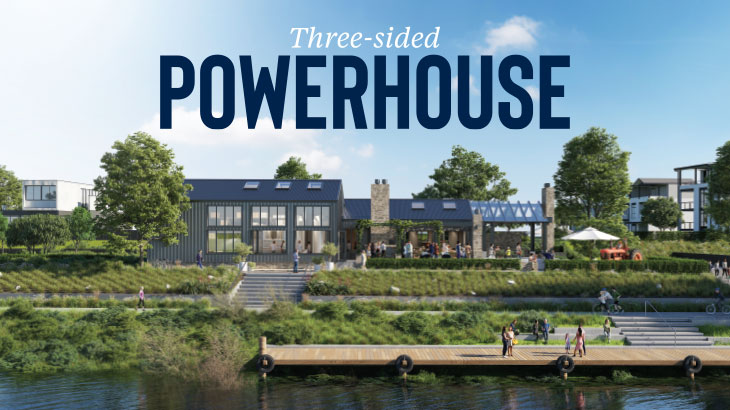Three-sided powerhouse
The Golden Triangle continues to house the lion’s share of New Zealand’s economic productivity and it remains on a growth trajectory.
Total Property - Issue 8 2021
The upper North Island’s “Golden Triangle” zone formed by the Auckland, Waikato, and Bay of Plenty regions, retains its badge as the dominant focus of property development activity in New Zealand.
It’s responsible for nearly 60 percent of the country’s building consents issued annually and where big business is consolidating.
Bayleys Research’s latest Golden Triangle Overview, part of its Infrastructure series of reports, underlines the major contribution the three provinces make to New Zealand’s productivity and gross domestic product (GDP).
Accounting for just over half of New Zealand’s population (50.18 percent), the zone accounted for 52.4 percent of New Zealand’s GDP growth in the year to March 2021 and $11.978 billion – or 57.12 percent – of the value of all building consents issued.
That represents an increase of more than $1 billion in consents since 2019.
Ryan Johnson, Bayleys’ national director commercial and industrial says the Golden Triangle’s robust new development activity is across all property sectors and despite COVID disruptors, he expects this dominance to persist in the medium to longer term.
“Given the continued demand being demonstrated by the market, the Golden Triangle’s supremacy as New Zealand’s economic powerhouse looks certain to endure.”
The industrial sector has led non-residential building development activity, supercharged by the uptick in ecommerce dynamics and its demand for logistics-related space.
“Over the last decade, annual industrial building consents issued have more than doubled in the Golden Triangle from under 300,000 square metres of space in 2012 to 650,000 square metres in the 12 months to March 31, 2021, with Bay of Plenty industrial consents rising almost 100 percent in that time,” explains Johnson.
He says while Auckland’s role in the business and fiscal realms of the Golden Triangle is well-documented, the fundamentals of the triangle have matured.
“Once the domain of private investment money, the Golden Triangle zone is now attracting significant institutional and listed development investment – along with central government input.
“An example being Tauranga-based property entity Classic Group which has partnered with the NZ Super Fund to form a new land development company and will leverage its scale and capital to increase housing supply in New Zealand, with a focus on the Auckland market in the first instance.
“Classic Group has previously partnered with Western Bay of Plenty District Council to deliver affordable housing in Omokoroa, has done a joint venture project in Pāpāmoa, has earmarked a substantial landholding for development within Tauriko in Tauranga, has been involved with KiwiBuild developments in Tauranga, and undertaken many residential projects with scale in Auckland.”
In Tauranga, Mark Walton, Bayleys’ commercial and industrial manager says the green light for Winstone Wallboard’s new $400 million plasterboard manufacturing and distribution facility in the Tauriko Business Estate, is a standout injection of confidence in the region.
“The 200-hectare Tauriko estate which incorporates one of Australasia’s largest industrial subdivisions, continues to account for the bulk of the current industrial building activity in Tauranga, however, future development land in the precinct is constrained.
“Design-build opportunities are filling up and industrial occupiers will need to act quickly to nab space – particularly for large footprint options.
“There’s a chronic shortage of business-zoned land in the region and the squeeze is on to meet the demand.”
Meanwhile, the Rangiuru Business Park near Te Puke in the Bay of Plenty, will open up around 178 hectares of land for development across four stages, accommodating large footprint industrial facilities and having a dedicated interchange connecting it to the Tauranga Eastern Link expressway and a direct rail link to the Port of Tauranga.
In the Waikato right now, Te Rapa in north Hamilton is seeing the bulk of the region’s new industrial development given land availability and access to motorway connections north and south.
David Cashmore, Bayleys Waikato’s commercial manager says there has been rapid uptake of sites in new subdivisions on the city’s northern boundary, such as the 60-hectare Te Rapa Gateway alongside State Highway 1.
“Hamilton is experiencing unprecedented growth – much of it attributed to the Golden Triangle dynamics of being the next big cab off the rank heading south from Auckland.
“New roading and infrastructure along with 10 years of increased population growth has given investors and occupiers the confidence to move their focus southwards and development is happening across the property sector and with significant scale.”
Cashmore says without doubt, Tainui Group Holdings’ (TGH) new Ruakura Superhub that’s emerging out of the ground alongside the Waikato Expressway, will be transformational for Waikato’s business fundamentals.
“TGH’s 490-hectare master-planned development on Hamilton’s eastern fringe has almost 200 hectares allocated for logistics and industrial uses alone and will boast a substantial inland port.
“Once up-and-running, this precinct will kick the regional economy – and the part it plays in the broader Golden Triangle’s GDP – into a whole new gear.”
Likewise, he says Te Awa Lakes, a master-planned community on the site of a former quarry in Horotiu, will create housing, commercial and recreational opportunities on a scale that the region is crying out for.
“It’s a fast-moving game in the Waikato – and exciting to be part of.”
To access Bayleys Research’s latest Golden Triangle Overview, head to bayleys.co.nz/research/commercial
Read more market insights from Total Property
Subscribe to receive the latest commercial news and insights from Bayleys Total Property
